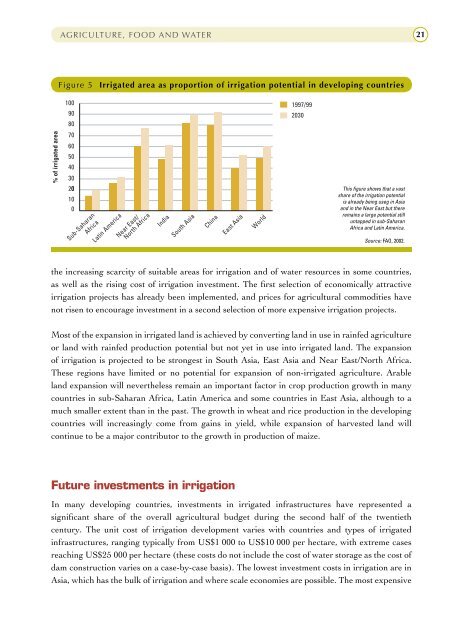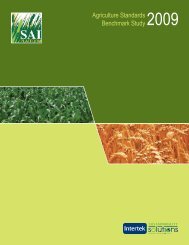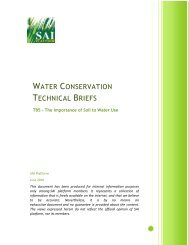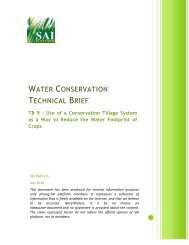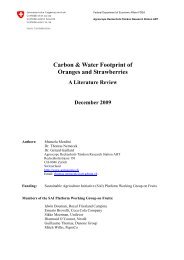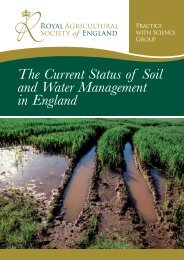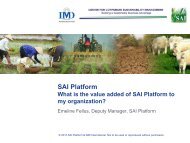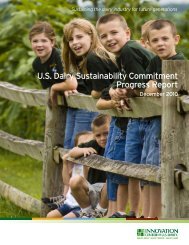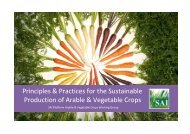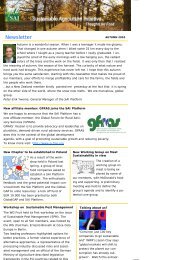Agriculture, food and water - FAO.org
Agriculture, food and water - FAO.org
Agriculture, food and water - FAO.org
Create successful ePaper yourself
Turn your PDF publications into a flip-book with our unique Google optimized e-Paper software.
AGRICULTURE, FOOD AND WATER<br />
21<br />
Figure 5 Irrigated area as proportion of irrigation potential in developing countries<br />
100<br />
90<br />
80<br />
1997/99<br />
2030<br />
% of irrigated area<br />
70<br />
60<br />
50<br />
40<br />
30<br />
20<br />
10<br />
0<br />
Sub-Saharan<br />
Africa<br />
Latin America<br />
Near East/<br />
North Africa<br />
India<br />
South Asia<br />
China<br />
East Asia<br />
World<br />
This figure shows that a vast<br />
share of the irrigation potential<br />
is already being useg in Asia<br />
<strong>and</strong> in the Near East but there<br />
remains a large potential still<br />
untapped in sub-Saharan<br />
Africa <strong>and</strong> Latin America.<br />
Source: <strong>FAO</strong>, 2002.<br />
the increasing scarcity of suitable areas for irrigation <strong>and</strong> of <strong>water</strong> resources in some countries,<br />
as well as the rising cost of irrigation investment. The first selection of economically attractive<br />
irrigation projects has already been implemented, <strong>and</strong> prices for agricultural commodities have<br />
not risen to encourage investment in a second selection of more expensive irrigation projects.<br />
Most of the expansion in irrigated l<strong>and</strong> is achieved by converting l<strong>and</strong> in use in rainfed agriculture<br />
or l<strong>and</strong> with rainfed production potential but not yet in use into irrigated l<strong>and</strong>. The expansion<br />
of irrigation is projected to be strongest in South Asia, East Asia <strong>and</strong> Near East/North Africa.<br />
These regions have limited or no potential for expansion of non-irrigated agriculture. Arable<br />
l<strong>and</strong> expansion will nevertheless remain an important factor in crop production growth in many<br />
countries in sub-Saharan Africa, Latin America <strong>and</strong> some countries in East Asia, although to a<br />
much smaller extent than in the past. The growth in wheat <strong>and</strong> rice production in the developing<br />
countries will increasingly come from gains in yield, while expansion of harvested l<strong>and</strong> will<br />
continue to be a major contributor to the growth in production of maize.<br />
Future investments in irrigation<br />
In many developing countries, investments in irrigated infrastructures have represented a<br />
significant share of the overall agricultural budget during the second half of the twentieth<br />
century. The unit cost of irrigation development varies with countries <strong>and</strong> types of irrigated<br />
infrastructures, ranging typically from US$1 000 to US$10 000 per hectare, with extreme cases<br />
reaching US$25 000 per hectare (these costs do not include the cost of <strong>water</strong> storage as the cost of<br />
dam construction varies on a case-by-case basis). The lowest investment costs in irrigation are in<br />
Asia, which has the bulk of irrigation <strong>and</strong> where scale economies are possible. The most expensive


